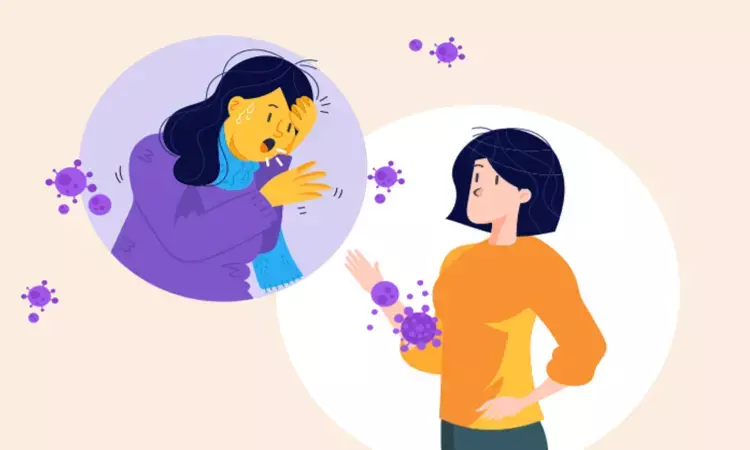- Home
- Medical news & Guidelines
- Anesthesiology
- Cardiology and CTVS
- Critical Care
- Dentistry
- Dermatology
- Diabetes and Endocrinology
- ENT
- Gastroenterology
- Medicine
- Nephrology
- Neurology
- Obstretics-Gynaecology
- Oncology
- Ophthalmology
- Orthopaedics
- Pediatrics-Neonatology
- Psychiatry
- Pulmonology
- Radiology
- Surgery
- Urology
- Laboratory Medicine
- Diet
- Nursing
- Paramedical
- Physiotherapy
- Health news
- Fact Check
- Bone Health Fact Check
- Brain Health Fact Check
- Cancer Related Fact Check
- Child Care Fact Check
- Dental and oral health fact check
- Diabetes and metabolic health fact check
- Diet and Nutrition Fact Check
- Eye and ENT Care Fact Check
- Fitness fact check
- Gut health fact check
- Heart health fact check
- Kidney health fact check
- Medical education fact check
- Men's health fact check
- Respiratory fact check
- Skin and hair care fact check
- Vaccine and Immunization fact check
- Women's health fact check
- AYUSH
- State News
- Andaman and Nicobar Islands
- Andhra Pradesh
- Arunachal Pradesh
- Assam
- Bihar
- Chandigarh
- Chattisgarh
- Dadra and Nagar Haveli
- Daman and Diu
- Delhi
- Goa
- Gujarat
- Haryana
- Himachal Pradesh
- Jammu & Kashmir
- Jharkhand
- Karnataka
- Kerala
- Ladakh
- Lakshadweep
- Madhya Pradesh
- Maharashtra
- Manipur
- Meghalaya
- Mizoram
- Nagaland
- Odisha
- Puducherry
- Punjab
- Rajasthan
- Sikkim
- Tamil Nadu
- Telangana
- Tripura
- Uttar Pradesh
- Uttrakhand
- West Bengal
- Medical Education
- Industry
Coronavirus may be present in eye secretions- risk for health workers

Severe acute respiratory syndrome coronavirus 2 (SARS-CoV-2), the virus that causes COVID-19, may be present in conjunctival secretions of infected patients, according to a report from China.
However, whether the virus can be transmitted through conjunctiva remains to be determined, say Liang Liang and Ping Wu from Yichang Central People's Hospital in Hubei, which has borne the brunt of the epidemic.
According to their report in Acta Ophthalmologica, 37 patients with COVID-19 pneumonia underwent reverse transcriptase PCR to look for evidence of the virus in conjunctival secretion; 12 of these patients had severe and the others mild COVID-19. Three patients also had conjunctival congestion and other inflammatory ocular findings.
One of the 37 patients had evidence of the virus in conjunctival secretion and this patient had no conjunctivitis. The other 36 patients were negative.
"The viral load of conjunctival sac secretion of COVID-19 patients is relatively low, and we estimate the viral load is directly proportional to the severity of the disease," write Liang and Wu.
In email to Reuters Health, Liang said it's important for ophthalmologists to realize the patient's conjunctival secretions may carry a virus. "When checking the patient's eyes, the doctor must wear protective goggles and gloves and wash hands after the exam." When examining patients for eye diseases, "it is best to use ophthalmic equipment to check, and try to avoid manual detection," said Liang.
The authors of a related paper in Acta Ophthalmologica, who are also from China, speculate that the virus may enter the tears through droplets, which may pass through the nasolacrimal ducts and then into the respiratory tract.
"Combined with all this information, we assert that, when coming into contact with confirmed or suspected cases of COVID-19, healthcare workers should wear eye safety goggles. This should become one of the critical measures for preventing the spread of COVID-19," write Zongming Song and colleagues from Henan Eye Institute in Zhengzhou.
In a paper in Graefe's Archives for Clinical Experimental Ophthalmology, clinicians from Hong Kong offer guidance on stepping up infection control measures in ophthalmology during the coronavirus outbreak, based on their experience on the frontlines of the epidemic. (https://bit.ly/396XQpW)
A report last month in The Lancet also raised concern that ocular surfaces may be a potential target for SARS-CoV-2 invasion. (https://bit.ly/2JaxetK)
The American Academy of Ophthalmology (AAO) has advised ophthalmologists to suspend routine patient visits and provide only urgent care, with appropriate precautions, during the COVID-19 outbreak. (https://bit.ly/3bhNYv1)
Hina Zahid Joined Medical Dialogue in 2017 with a passion to work as a Reporter. She coordinates with various national and international journals and association and covers all the stories related to Medical guidelines, Medical Journals, rare medical surgeries as well as all the updates in the medical field. Email: editorial@medicaldialogues.in. Contact no. 011-43720751
Dr Kamal Kant Kohli-MBBS, DTCD- a chest specialist with more than 30 years of practice and a flair for writing clinical articles, Dr Kamal Kant Kohli joined Medical Dialogues as a Chief Editor of Medical News. Besides writing articles, as an editor, he proofreads and verifies all the medical content published on Medical Dialogues including those coming from journals, studies,medical conferences,guidelines etc. Email: drkohli@medicaldialogues.in. Contact no. 011-43720751


